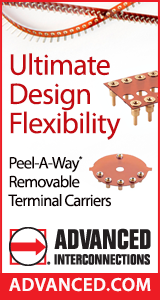|

|
|
|
||||||||
Issues With SMT Component Alignment
Board Talk
|
||||||||
TranscriptPhil And welcome to Board Talk with Jim Hall and Phil Zarrow of ITM Consulting. We are here to help you attempt to resolve your process problems with components, materials, everything under the sun. Jim, there seems to be something in the air these days with regard to component shifting. We have three questions today on this topic. I think we will tackle all three of them. The first one is from V.E. V.E. says, we have a problem with chip component shifting that is detected during automatic optical inspection. The shifting is not limited to single components and changes daily, sometimes at one location and sometimes at the other location. What is likely causing it and how can we overcome this problem? The next question is from F.S. F.S. says we are losing large, two pin SMT inductor. During reflow it rotates almost 30 degrees. We have designed the footprint according to the manufacturer data sheet. Why is this component rotating during reflow? This is from M.M. M.M. says what could be the root cause of SMT LED component shift during reflow? Jim I would suggest we break it into two possibilities, Phil. Either it was misaligned before reflow or misalignment during reflow. Some of these people say during reflow, but we don't know. Are they really inspecting the part post placement, just before they go into the oven, to make sure that the part is properly aligned or could it have been misaligned ahead of time? Anything is possible. I want to complement F.S. for identifying the importance of proper pad design. They said, we design the footprint according to the manufacturer's data sheet. And that is assuming that the manufacturer is giving them good data. If we are talking about alignment or misalignment during reflow, pad dimensions, pad size, shape and spacing is really important. If it is misaligning during reflow, it is because the surface tension forces formed as the solder starts to wet are out of balance and they are pulling the component out of alignment. The size and shape of the pads on the board are one of the most important thing affecting those surface tension forces. That is very important in all cases. To the other two, I would say have you designed your pads correctly? Although in the first one where it is moving around and not limited to one location, that would sort of negate that theory. Phil Assuming for the moment, along with F.S., that the other guys have done their aperture design correctly. To F.S., are you possibly putting down too much solder paste? What is your solder paste height? Are you adhering to proper guidelines with regard to the area ratio? And that applies to the other guys. Jim Particularly to V.E., where it isn't consistent. Is something in your printing process, your aperture shapes, your squeegee parameters causing a lot of variability so that you get inconsistent volumes of paste deposited that at certain extremes can cause misalignment. Phil So then looking at the pick and place machine, never disregard the obvious. You may have something wrong with your program. That is one thing. Jim Worn nozzles, incorrect nozzles. PhilExactly, clock nozzles. Jim They are not gripping the component accurately. Bottom line the placement machine is not placing it in proper alignment every time. Phil And also, is your vision correction working correctly when you pick the component out of the tape pocket too? Certainly, among other things is what is your Z axis position when you place the part. Best practices is to have the components sit between 1/3 and 2/3 into the solder paste deposit. If you are coming down to slight, it is going to float on top. I have seen that happen quite a bit. That would be another thing to check in your program with regard to the suspect components. What is your Z-axis positioning, or force if your machine is equipped with such? Jim Finally, just maintenance of the reflow oven, the conveyor. Vibration in the conveyor is one of the most significant causes of misalignment. They are sitting on those little pins on the edge conveyors, any vibration in the conveyor can cause those components to move particularly in the critical phase just as the solder is beginning to melt and the surface tension is starting to take over. They are very vulnerable. Imbalances in the air flow, clogged nozzles, imbalanced fans, just basic maintenance problems with the oven. Phil Well, V.E., S.S. and M.M. we have given you folks a lot to think about and consider. No doubt our readers will be interjecting a few good points too. Good luck in your endeavor. Thank you for listening to Board Talk with Jim Hall and Phil Zarrow. No matter what kind of components you are placing and attempting to reflow and no matter how far askew they go, whatever you do, please don't solder like my brother. Jim And don't solder like my brother. |
||||||||
Comments
|
||||||||
|
|

|




